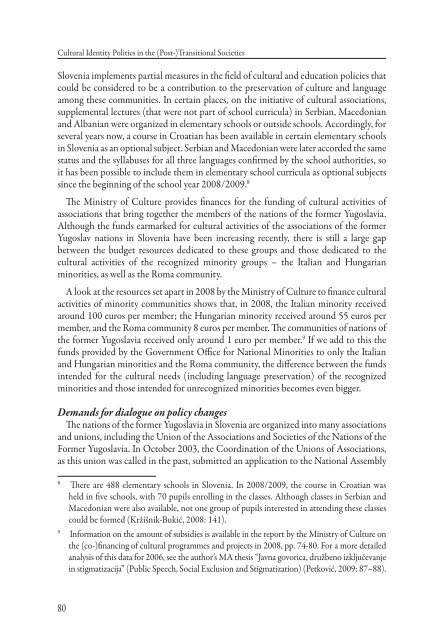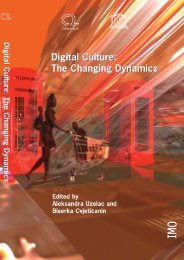free download in pdf format - Culturelink Network
free download in pdf format - Culturelink Network
free download in pdf format - Culturelink Network
You also want an ePaper? Increase the reach of your titles
YUMPU automatically turns print PDFs into web optimized ePapers that Google loves.
Cultural Identity Politics <strong>in</strong> the (Post-)Transitional Societies<br />
Slovenia implements partial measures <strong>in</strong> the fi eld of cultural and education policies that<br />
could be considered to be a contribution to the preservation of culture and language<br />
among these communities. In certa<strong>in</strong> places, on the <strong>in</strong>itiative of cultural associations,<br />
supplemental lectures (that were not part of school curricula) <strong>in</strong> Serbian, Macedonian<br />
and Albanian were organized <strong>in</strong> elementary schools or outside schools. Accord<strong>in</strong>gly, for<br />
several years now, a course <strong>in</strong> Croatian has been available <strong>in</strong> certa<strong>in</strong> elementary schools<br />
<strong>in</strong> Slovenia as an optional subject. Serbian and Macedonian were later accorded the same<br />
status and the syllabuses for all three languages confi rmed by the school authorities, so<br />
it has been possible to <strong>in</strong>clude them <strong>in</strong> elementary school curricula as optional subjects<br />
s<strong>in</strong>ce the beg<strong>in</strong>n<strong>in</strong>g of the school year 2008/2009. 8<br />
Th e M<strong>in</strong>istry of Culture provides fi nances for the fund<strong>in</strong>g of cultural activities of<br />
associations that br<strong>in</strong>g together the members of the nations of the former Yugoslavia.<br />
Although the funds earmarked for cultural activities of the associations of the former<br />
Yugoslav nations <strong>in</strong> Slovenia have been <strong>in</strong>creas<strong>in</strong>g recently, there is still a large gap<br />
between the budget resources dedicated to these groups and those dedicated to the<br />
cultural activities of the recognized m<strong>in</strong>ority groups – the Italian and Hungarian<br />
m<strong>in</strong>orities, as well as the Roma community.<br />
A look at the resources set apart <strong>in</strong> 2008 by the M<strong>in</strong>istry of Culture to fi nance cultural<br />
activities of m<strong>in</strong>ority communities shows that, <strong>in</strong> 2008, the Italian m<strong>in</strong>ority received<br />
around 100 euros per member; the Hungarian m<strong>in</strong>ority received around 55 euros per<br />
member, and the Roma community 8 euros per member. Th e communities of nations of<br />
the former Yugoslavia received only around 1 euro per member. 9 If we add to this the<br />
funds provided by the Government Offi ce for National M<strong>in</strong>orities to only the Italian<br />
and Hungarian m<strong>in</strong>orities and the Roma community, the diff erence between the funds<br />
<strong>in</strong>tended for the cultural needs (<strong>in</strong>clud<strong>in</strong>g language preservation) of the recognized<br />
m<strong>in</strong>orities and those <strong>in</strong>tended for unrecognized m<strong>in</strong>orities becomes even bigger.<br />
Demands for dialogue on policy changes<br />
Th e nations of the former Yugoslavia <strong>in</strong> Slovenia are organized <strong>in</strong>to many associations<br />
and unions, <strong>in</strong>clud<strong>in</strong>g the Union of the Associations and Societies of the Nations of the<br />
Former Yugoslavia. In October 2003, the Coord<strong>in</strong>ation of the Unions of Associations,<br />
as this union was called <strong>in</strong> the past, submitted an application to the National Assembly<br />
8 Th ere are 488 elementary schools <strong>in</strong> Slovenia. In 2008/2009, the course <strong>in</strong> Croatian was<br />
held <strong>in</strong> fi ve schools, with 70 pupils enroll<strong>in</strong>g <strong>in</strong> the classes. Although classes <strong>in</strong> Serbian and<br />
Macedonian were also available, not one group of pupils <strong>in</strong>terested <strong>in</strong> attend<strong>in</strong>g these classes<br />
could be formed (Kržišnik-Bukić, 2008: 141).<br />
9 In<strong>format</strong>ion on the amount of subsidies is available <strong>in</strong> the report by the M<strong>in</strong>istry of Culture on<br />
the (co-)fi nanc<strong>in</strong>g of cultural programmes and projects <strong>in</strong> 2008, pp. 74-80. For a more detailed<br />
analysis of this data for 2006, see the author’s MA thesis “Javna govorica, družbeno izključevanje<br />
<strong>in</strong> stigmatizacija” (Public Speech, Social Exclusion and Stigmatization) (Petković, 2009: 87–88).<br />
80



